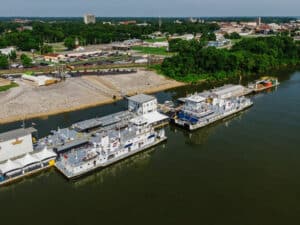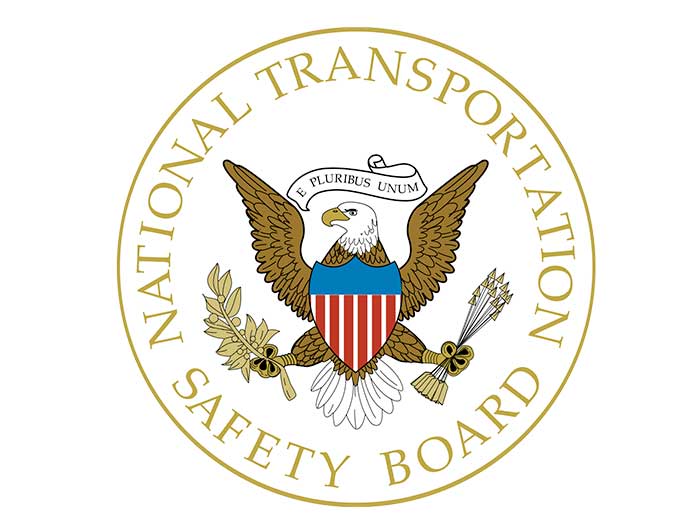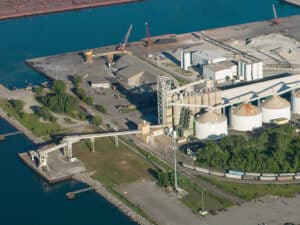
NTSB reports on costly contact of tow with railroad bridge protection cell
Written by Marine Log Staff
The National Transportation Safety Board has issued its report on an incident in which, at 12.32 a.m. local time on January 1, 2020, the towing vessel William C was pushing a tow of six loaded hopper barges on the Des Plaines River, near Joliet, Ill., when the tow’s two forward barges struck a protection cell for the Rock Island Railroad Bridge at mile 287.6. Several tow lines broke, and two barges sustained minor damage.
The bridge ceased operations for 10 days, and damages to the bridge’s protection cell were estimated to be greater than $500,000.
No injuries or pollution were reported.
As usual, to get the full picture of what happened, you have to read the full report, however it is interesting to note that the protection cell hit by the tow was one of four concrete protection cells with floating fenders connected to a pier placed in front of and along the side of the structure and foundation to absorb and/or deflect the force of a vessel coming into contact with them.
To assist with nighttime navigation, the center of the channel under the open bridge was marked with a green light, and each protection cell, pier, and support was marked with a red light.
The accident pilot told investigators that on the night of the casualty, all the navigation lights were operating properly.
Owned by Illinois Marine Towing and operated by Inland Rivers Corporation, the 76.5-foot towing vessel William C was built in 1967 in Grafton, Illinois, to serve within the Illinois Waterway. It was powered by two diesel engines, each producing 600 horsepower and driving one propeller (two propellers total). The pilot house on the vessel could be hydraulically raised to maintain forward visibility over barges in a tow and lowered to allow the vessel to transit through low bridges.
The William C departed the Illinois Marine Towing Fleet facility located at mile 299 on the Chicago Sanitary and Ship Canal—which connects with the Des Plaines River—in Lemont, Illinois, at 10.05 p.m on December 31, 2019, with a crew of six, including a captain, pilot, and four deckhands.
In its analysis of the incident, the NTSB reports that yhe river flow at the time of the accident (6,500 cfs) was very high, but the Waterways Action Plan did not require risk mitigation measures, and the pilot stated that he was comfortable with maneuvering the tow in the 3 mph following current. The pilot controlled the William C tow without issue from the Illinois Marine Towing Fleet facility at mile 299, traveling with the current at a speed of 5 mph over ground—approximately 2 mph over the speed of the river—in order to maintain steering control.
At the time the tow was passing through the Cass Street Bridge and approaching the Jefferson Street Bridge, the following current in the bend would have been impacting the vessel’s starboard quarter, pushing the tow over to port and the left descending bank. When the pilot approached the Jefferson Street Bridge, he realized that he had oversteered to port, so he moved the rudders to maneuver the tow to starboard to line up the vessel with the center of the bridge. Once the pilot believed the vessel was lined up, he returned the rudders to midships, but the current pushed the vessel back to port. Since the bow of the tow was already approaching the Jefferson Street Bridge, the pilot continued his course until the William C had passed the bridge.
Once the vessel had passed through the bridge, there was only about 1,200 feet for the pilot to maneuver the approximately 662-foot-long tow back to the center of the channel before reaching the Rock Island Railroad Bridge protection cell near the left descending bank. The pilot attempted to move the tow to starboard, but, since the following current was pushing against the tow, it continued toward the left descending bank. When the pilot determined there was not enough time to move the vessel in order to avoid striking the bridge, he reversed both engines to slow the vessel, which reduced the force of the impact but did not prevent the
Contact of William C Tow with Rock Island Railroad Bridge Protection Cell Probable Cause
PROBABLE CAUSE
The National Transportation Safety Board determines that the probable cause of the contact with the protection cell by the William C and tow was the pilot’s inability to correct the tow’s position after completing the transit through the previous bridge, in part due to the higher-than-average current speed.
Download the full report HERE

![Tom Frazier aground and listing to starboard on Feb. 11, 2024. [Photo: U.S. Coast Guard]](https://www.marinelog.com/wp-content/uploads/2025/06/Towboataground-300x225.jpg)


